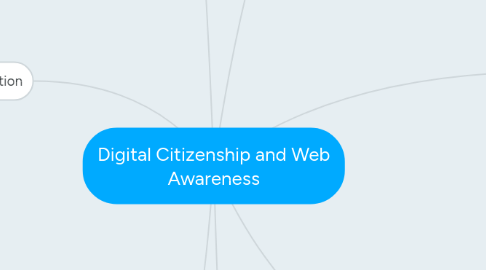
1. Digital Etiqeutte
1.1. Netiquette
1.1.1. Rules for how to behave online
1.1.1.1. Ask permission before positing
1.1.1.2. Do not upload violent content
1.1.1.3. Sandwich Technique for criticisms
1.1.1.4. Use Earphones in public
1.1.2. Apropriate Communcation
1.1.2.1. Email
1.1.2.2. Blogs
1.1.2.3. Social Networking
1.1.3. Flaming (Heated online arguements
1.1.4. Anonymous
1.2. Clear Communiation
1.2.1. Easy to read/understand
1.2.2. All caps = yelling
1.2.3. Re-read before sending
2. Authenticity of Information
2.1. Internet = Unlimited information
2.1.1. Where information is from
2.1.2. Reliable Sources
2.1.3. Accurate Informaiton
2.1.4. Biases
2.2. Publishing information
2.2.1. Proper citations
2.2.2. Factual information
2.2.3. Appropriate Content
2.3. Email Validity
2.3.1. Secure/trusted adresses
3. Classroom Use
3.1. Collaboration
3.2. Internet Saftey
3.2.1. Media Smarts
3.2.1.1. Keep kids safe online
3.2.1.2. For parents and teachers
3.2.2. Common Sense Media
3.2.2.1. K-12 Digital Citizenship Curriculum
3.2.2.2. Lesson plans
3.2.2.3. Classroom resources
3.2.3. Cybertips for teachers
4. Respect
4.1. Self
4.1.1. Personal Information
4.1.2. Appropriate Pictures
4.2. Others
4.2.1. Appropriate interactions
4.3. Intellectual Property
4.3.1. Copyright
4.3.1.1. Laws to protect intelectual right
4.3.1.2. Copy/Paste
4.3.1.3. Fair use
4.3.1.4. Creative Commons website
4.3.1.4.1. User rights
4.3.1.5. Moral obligation to teacher
4.3.1.5.1. Model appropriate uses
5. Digital Literacy
5.1. Ethics
5.1.1. Ethical Core/Behaviours
5.1.2. Ethical Participants
5.1.3. Ethical Thinking Online
5.1.3.1. Ethical Dilemmas (Chart it game)
5.1.4. Good Play (5)
5.1.4.1. Identity
5.1.4.2. Privacy
5.1.4.2.1. (Fakebook for students)
5.1.4.3. Ownership
5.1.4.4. Trustworthiness
5.1.4.5. Participation
5.1.4.5.1. Digital Life Unit
5.2. Cyber Bullying
5.2.1. bullying.org
6. Marketing
6.1. Targeting kids
6.1.1. Online advertisments
6.1.2. Pop-ups
6.2. Media Smarts website
7. Privacy
7.1. Smartphones
7.1.1. Private pictures
7.1.1.1. Once online always online
7.1.1.2. Hackers can find locations
7.2. Cyberbullying
7.3. Personal information
7.3.1. Hacking/Cherrypicking
